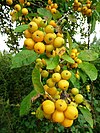
Malus is a genus of about 30–55 species of small deciduous trees or shrubs in the family Rosaceae, including the domesticated orchard apple, crab apples and wild apples.

Koelreuteria paniculata is a species of flowering plant in the family Sapindaceae, native to eastern Asia. It was introduced in Europe in 1747, and to America in 1763, and has become a popular landscape tree worldwide. Common names include goldenrain tree, pride of India, China tree, and the varnish tree.
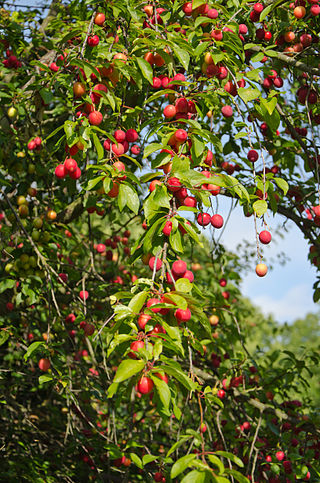
Prunus cerasifera is a species of plum known by the common names cherry plum and myrobalan plum. It is native to Southeast Europe and Western Asia, and is naturalised in the British Isles and scattered locations in North America. Also naturalized in parts of SE Australia where it is considered to be a mildly invasive weed of bushland near urban centers.

Cornus alba, the red-barked, white or Siberian dogwood, is a species of flowering plant in the family Cornaceae, native to Siberia, northern China and Korea. It is a large deciduous surculose (suckering) shrub that can be grown as a small tree. As a popular ornamental used in landscaping its notable features include the red stems in fall (autumn) through late winter, bright winter bark; and the variegated foliage in some cultivars, such as C. alba 'Elegantissima'. C. alba can grow to 3 m (10 ft) high, but variegated forms are less vigorous. For the brightest winter bark, young shoots are encouraged by cutting to the ground some older stems at the end of the winter, before leaves are open. The oval fruits are white, sometimes tinted blue.

Miscanthus sinensis, the eulalia or Chinese silver grass, is a species of flowering plant in the grass family Poaceae, native to eastern Asia throughout most of China, Japan, Taiwan and Korea.

Codiaeum variegatum is a species of plant in the genus Codiaeum, which is a member of the family Euphorbiaceae. It was described by Carl Linnaeus in 1753. It is native to Indonesia, Malaysia, Australia, and the western Pacific Ocean islands, growing in open forests and scrub.
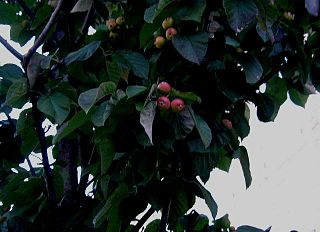
Macromeles tschonoskii is a species of flowering plant in the family Rosaceae. It is a tree endemic to Japan.

Malus floribunda, common name Japanese flowering crabapple, Japanese crab, purple chokeberry, or showy crabapple, originates from Japan and East Asia. It may be a hybrid of M. toringo with M. baccata, in which case it would be written as Malus × floribunda.

Osmanthus heterophyllus, variously known as holly osmanthus, holly olive, and false holly, is a species of flowering plant in the olive family Oleaceae, native to eastern Asia in central and southern Japan and Taiwan.
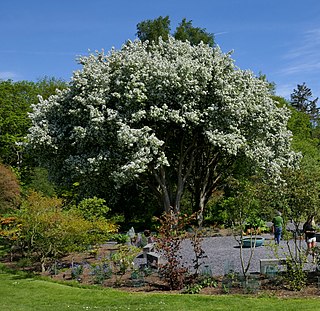
Malus hupehensis, common names Chinese crab apple, Hupeh crab or tea crabapple, is a species of flowering plant in the apple genus Malus of the family Rosaceae.

Malus fusca, with the common names Oregon crabapple and Pacific crabapple, is a species of crabapple native to western North America.

Malus angustifolia, or southern crabapple, is a species of crabapple native to the eastern and south-central United States.

Malus baccata is an Asian species of apple known by the common names Siberian crab apple, Siberian crab, Manchurian crab apple and Chinese crab apple. It is native to many parts of Asia, but is also grown elsewhere as an ornamental tree and for rootstock. It is used for bonsai. It bears plentiful, fragrant, white flowers and edible red to yellow fruit of about 1 cm diameter.
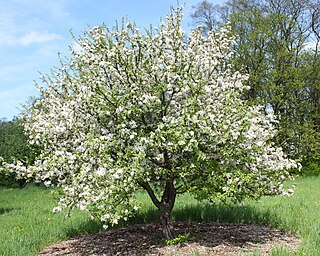
Malus prunifolia is a species of crabapple tree known by the common names plumleaf crab apple, plum-leaved apple, pear-leaf crabapple, Chinese apple and Chinese crabapple. It is native to China, and is grown elsewhere for use as an ornamental tree or as rootstock. It reaches from between 3 and 8 meters tall and bears white flowers and yellow or red fruit.

Malus sieboldii, commonly called Siebold's crab, Siebold's crabapple or Toringo crabapple, is a species of crabapple in the family Rosaceae.

Acer palmatum, commonly known as Japanese maple, palmate maple, or smooth Japanese maple (Korean: danpungnamu, 단풍나무, Japanese: irohamomiji, イロハモミジ, or momiji,, is a species of woody plant native to Korea, Japan, China, eastern Mongolia, and southeast Russia. Many different cultivars of this maple have been selected and they are grown worldwide for their large variety of attractive forms, leaf shapes, and spectacular colors.

Disanthus cercidifolius is a species of flowering plant in the family Hamamelidaceae. It is native to woodland habitats in China and Japan.
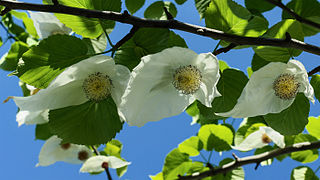
Davidia involucrata, the dove-tree, handkerchief tree, pocket handkerchief tree, or ghost tree, is a medium-sized deciduous tree in the family Nyssaceae. It is the only living species in the genus Davidia. It was previously included with tupelos in the dogwood family, Cornaceae. Fossil species are known extending into the Upper Cretaceous.

Malus PERPETU 'Evereste' is an ornamental cultivar of crabapple that was developed by INRA in 1974 and is registered under their trademark with the name Malus perpetu.

Prunus davidiana is a species in the genus Prunus in the family Rosaceae. It is also known by the common names David's peach and Chinese wild peach. It is native to China, preferring to grow in forests and thickets, on slopes in mountain valleys, and in waste fields, from 800 to 3200 m. It is resistant to frost, and to a number of pests and diseases of cultivated peach, and is the subject of many studies for the genetic improvement of peaches.























